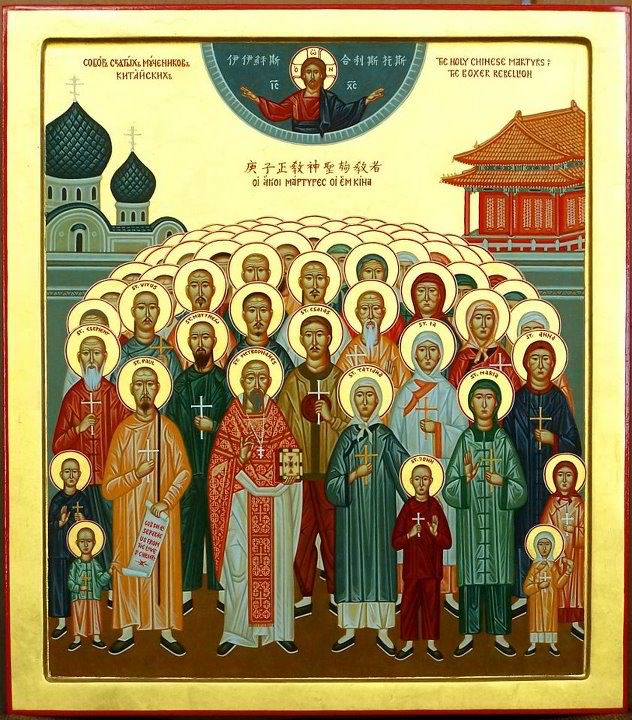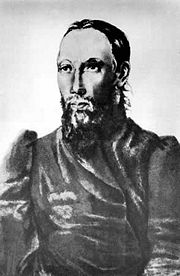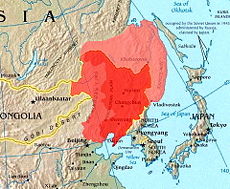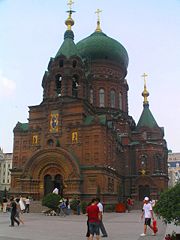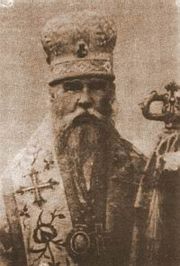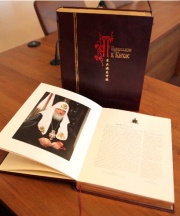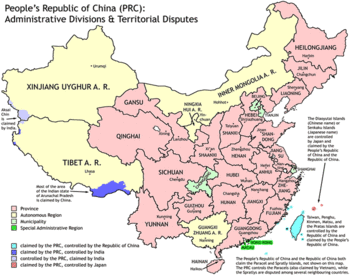Synod decision No. 31 of December 27, 1945 set forth that from October 26, 1945 the church hierarchy, including archbishops, bishops and archimandrites, the head of the Korean Mission,
[1]and the clergy and secular residents of the Harbin eparchy would join the Russian Orthodox Church. An integrated metropolitan district was formed in China and Korea which was called the Harbin and East Asian Metropolitan District. Archbishop
Nestor was appointed to temporarily govern the metropolitan district. The metropolitan district was transformed into the East Asian Exarchate (a district uniting several eparchies and enjoying a certain amount of independence) by patriarchal Decree No. 664 of June 11, 1946. Archbishop Nestor was appointed patriarchal exarch with a promotion in rank to Harbin and Manchurian metropolitan. The Russian Ecclesiastical Mission was under the direct jurisdiction of the Moscow Patriarchate.
On October 22, 1946, the Holy Synod resolved to appoint Beijing Archbishop
Victor (Sviatin)head of the Russian Ecclesiastical Mission in China and consider him under the jurisdiction of the Exarchate in eparchial matters and under the personal jurisdiction of the exarch in Mission matters. This same resolution declared the Beijing eparchy and its Shanghai vicarship part of the East Asian Exarchate. Thus, two church centres formed in China, the Exarchate in Harbin and the Mission in Beijing. The activity of His Eminence Nestor in his post as head of the Exarchate was extremely diverse. It is enough to mention that the Moscow Patriarchate frequently used the printed publications of the Harbin eparchy during those years. In the Exarchate, Metropolitan Nestor supported the traditions of church charity work in every possible way. The situation of the Mission in Kuomintang-ruled China was also complicated by the hostile attitude of missionaries of other faiths towards it. They all saw the Mission as a "Soviet institution" in China. Incidentally, this is precisely what the Russian bishops also called it sometimes. The Mission owned an extensive economy, which was admittedly in need of restoration. Most of the local Russian clergy dreamed of returning to Russia, and some of them tried to emigrate. Mass emigration began after the declaration of the People's Republic of China in 1949. By the autumn of 1948, there were 8,000 White emigres living in Shanghai. Many of them tried to leave China in fear of communist reprisals. On May 4, 1949, Shanghai Archbishop
Ioann (Maximovich) also left for the Philippines with his congregation and clergy. Most of the eparchial property was exported, and the documents of the Mission Council partially destroyed.
The Orthodox Church in China and the Russian Ecclesiastical Mission faced new tasks involving the transfer from eparchial and parish activity to missionary service among the Chinese population. The first task the church authorities faced was clarifying the legal position of the Mission in China under the new state structure and official registration of its real estate.
Archbishop Victor suggested dividing the Mission's activity into five main aspects: missionary (the preaching of Orthodoxy among the Chinese population), monastic, cultural, economic and charitable. There were plans to establish a vital link with theological schools in Russia, organise theological training in Beijing for Chinese priests, reopen missionary camps that had been closed under Metropolitan In-nokenty at the beginning of Russian emigration to China, found theological academies in Beijing, Tianjin and Shanghai, as well as creating a mission to translate theological literature into Chinese. Cultural and educational activity was to consist of opening Russian primary schools, publishing Russian-Chinese periodicals, organising various lectures and courses, and opening new libraries at the missionary camps and in the parishes. However, the Mission head saw the main task in restoring its material foundation.
[2] In response to a report from Archbishop Victor, His Holiness Patriarch Aleksy I demanded on January 24, 1950 that "the Mission no longer be considered an income-bearing enterprise or some kind of feudal principality. Within a short time (less than ten years, for example), with the help of God, a Chinese Orthodox Church must be formed with Chinese hierarchy, Chinese priests and monks, Chinese missionaries and, most important, with a multitudinous Chinese congregation".
[3]
The Patriarch wrote about the necessary minimum at that time, training of clergy and translation of theological literature.
He sent a letter to G. Karpov, in charge of the department for Russian Orthodox Church Affairs under the USSR Council of Ministers with a request to clarify in the USSR Foreign Ministry the Chinese government's attitude towards the Mission's legal status with respect to its missionary and economic activity.
Archbishop Victor suggested eliminating the "diarchy" that had developed in church life in China by uniting the Exarchate, with its centre in Harbin, with the Mission in Beijing.
[4] There were also proposals to move the Mission Council from Shanghai to Beijing. The archbishop proposed a draft of new Regulations of the Mission. Missionary activity, which avoided "excessive zealousness for false proselytism", was defined as its main task.
In July 1950, by Decree No. 1170 of His Holiness the Patriarch, Beijing Archbishop Victor (Sviatin) was appointed Patriarchal Exarch of the East Asian Exarchate and head of the 20th Russian Ecclesiastical Mission in China. The residence of the Exarchate was located in Beijing. Bishop Nikander of Qiqikar was appointed deputy head of the Mission with his residence in Harbin. The following eparchies belonged to the Exarchate: Beijing (churches in Beijing, Hankou and Hong Kong), Harbin, Shanghai (churches in Shanghai and adjoining areas), Tianjin (churches in Tianjin and Qingdao; until the appointment of head bishop it was governed by the exarch) and Xinjiang (until the appointment of head bishop, it remained under the jurisdiction of the Moscow Patriarchate). By the same decree, the residences and business affairs of the East Asian Exarchate, the Russian Ecclesiastical Mission in China and the Mission Council in Shanghai were united in Beijing. The Mission Council was transformed into the Exarchate Council, and it was named the Episcopal Council. Until the Regulations of the East Asian Exarchate went into effect, a Provisional Administration was formed under the Exarchate which included missionary, administrative, economic and general departments. Archbishop Victor believed that open missionary work was essentially impossible in China, which was eloquently demonstrated by the history of all Christian missions. The Chinese people who were usually converted to Orthodoxy were those whose work was related with the Mission, blue- and white-collar workers. The Mission head believed that faith would come to them as they participated in the economic activity of the Mission.
The missionary service was faced with an enormous task translating theological literature into Chinese: 19th century translations in the old literary language, Wenyan, were inaccessible to many. The Mission had great problems with the extortionate taxes levied on its property. Some of the property, particularly the land, had to be transferred to the Chinese state agencies. Agrarian reform was supposed to remove all land from the Mission not stipulated in the Soviet-Chinese agreement of 1924 and then lease it back to it.
All the new difficulties meant first educating the Chinese priests, monks and bishops.
At one of the Synod meetings on China in July 1950 in Moscow, a decision was made to appoint archpriest Feodor Du as the bishop of Tianjin. On July 23, he was admited to monastic vows at the Trinity-St. Sergius Monastery and adopted the name of Simeon. On July 30, he was crowned bishop in the Epiphany Cathedral. In the autumn of 1950, Archbishop Victor blessed
Ioann Du,
Mikhail Li, Nikita Li,
Anikita Wang, and Ioann Luo as presbyters.
Falalei Mao,
Pinna Du,
Nikolai Zhang and
Antony Yao were made deacons.
The first step to creating a Chinese clergy was to be the catechetical school in Beijing. It was run by Archimandrite
Vassily (Shuang). In addition to candidates for preachers, it was made up of all the priests and deacons of the Mission. At the same time, a Women's School of Applied Knowledge was opened in Beijing. It was headed by a Chinese woman, Mother Superior Fiva.
In addition to the missionary schools in Beijing, there was also the Lyceum of Devoted Prince Alexander Nevsky in Harbin, a high school. A high school was opened at the church in Hankou for Chinese children, and there were several villages close to this town in which as many as 2,000 Orthodox Chinese lived. The zealous missionary, Priest Nikita Du, served in Hankou.
A translation commission was set up in Beijing comprised of six Chinese preachers and two secular transcribers. The commission was to engage in the translation of theological literature into contemporary Chinese.
The positive attitude of the Chinese clergy to the idea of building a Chinese Church was combined in some of them with chauvinistic and nationalistic attitudes. In particular, Bishop Simeon (Du), who had been transferred to Shanghai, tried to sow distrust in the Exarch among the Chinese clergy. For example, he convinced his relative, Priest Ioann Du, Father Superior of the Tianjin St. Innokenty Missionary Church, that the Mission head had supposedly been allotted special patriarchal benefits for this church, but kept them for himself.
[5] A conflict arose between Bishop Simeon and some of the Russian clergy of Shanghai on the grounds of personal disdain. Bishop Simeon continued to complain about his "hard" lot to the Patriarch, Prague Metropolitan Dorofei (he participated in the crowning of Bishop Simeon) and to other high-ranking officials. His attitude largely halted the missionary work of the Shanghai eparchy; however, most of the Chinese clergy was enthusiastic about creating a Chinese Church and tried to reap fruits on missionary soil.
Archbishop Victor conducted administrative reform in the Exarchate. An administration was formed under the Exarch which included three Russians and three Chinese preachers.
[6] He tried to include the Chinese clergy into the administration of the Exarchate: two Chinese and one Russian were members of the Auditing Commission, Chinese Priest Germogen Tang was placed at the head of the Mission's Higher Primary School, the post of cathedral archpriest was occupied by Father
Mikhail Min, Archimandrite Vassily (Shuang) was appointed the confessor, Leonid Liu became the Mission's housekeeper, and Deacon Nikolai Zhang was put in charge of the candle factory.
The Mission head tried to gain favour with the new state authorities to obtain their consent to register the eparchial administration and parishes. Due to this, he had to give the Mission's land plots in Badahangou (5 sq km), Kalgan, Dundinan, Beidaihe, Laoshan, and the province of Jiangxi to the Chinese authorities free of charge.
[7]
Archbishop Victor believed that successful missionary work required a second Chinese bishop. In his report to the Patriarch of February 16, 1951, he suggested that Archimandrite Vassily (Shuang), the Mission's confessor, be crowned bishop.
[8]
In Shanghai, a Chinese Orthodox fraternity was formed at the cathedral. A catechetical school operated here. Russian and Chinese language courses were held under the eparchial council, and up to 100 Chinese students studied Russian at the St. Andrew Church. Plans to create a Chinese Church in Manchuria were executed, and a Missionary Trustee Council under the Mission parish in Harbin was founded.
There were plans to begin negotiations with the Chinese Catholics, who had declared their independence from the Pope, as well as with the Protestants, on joining in a union headed by the Patriarch of Moscow and All Russia.
The Chinese authorities made attempts to oppose the activity of the Russian Ecclesiastical Mission as early as 1951. For example, in the summer of that year, Mission icons were confiscated under the pretence of transferring them to a museum as valuables of the Chinese people. Due to the grace of God, the icons were returned.
In 1951 and 1952, publication of the magazine Chinese Religious Bulletin was banned. With respect to religious associations, the principle of "three independences" was declared: self-government, self-financing and self-organisation. The authorities had rather a negative attitude towards any foreign religious presence. The Mission head defined a new religious policy in China as a course towards "the nationalisation of Christianity".
Due to the difficulties with obtaining permission for foreign citizens to travel around China, there was essentially no vital link between the eparchies and the parishes of the Exarchate. Publication of the Mission's magazine, which had been issued for 48 years, was banned, and for the same reason the Mission's printing house and book-binding shop ceased to function. Beijing's city authorities made the Mission's residents participate in beneficial social work in the town.
Apart from everything else, the internal life of the Exarchate was also complicated by the actions of the Shanghai Bishop, the Right Reverend Simeon Du. Bishop Simeon, "... was a restless person: he made an effort to sow confusion in the minds and hearts of the preachers and believers, giving himself rights and duties which were not granted him either by the supreme church authorities or by his position as head bishop of his eparchy".
[10] He believed that before giving the Chinese church an autonomous status, an autonomous eparchy was to be opened, headed by a Chinese bishop, who should be called "the Bishop of Beijing and All China".
[11] He asked to be allowed to open a parish of the Chinese Orthodox Church within the Beijing, Harbin, Tianjin and Xinjiang eparchies. Not waiting for a response from Moscow, Bishop Simeon sent all the orthodox Chinese within these eparchies questionnaires in which he asked their opinion about his plans to create an Autonomous Church in China. There were no objective grounds for Bishop Simeon to head the Orthodox Church in China. The Shanghai eparchy, just like the one in Beijing, faced material problems. In 1952, the eparchy's monetary income was reduced by 60%, mainly because of the departure of the Russian population from Shanghai. By the beginning of 1953, there were approximately 2,500 Europeans left in Shanghai, and by the end of the year only 1,000 remained, no more than 300 of whom were Orthodox Christians. Bishop Simeon suggested closing all churches, leaving only the cathedral open. The catechetical school was closed. By the summer of 1954, there were only about 200 Russians left in Shanghai, whereas the Chinese congregation did not constitute even 70 people. The only source of existence for the eparchy was a very small subsidy from the Patriarchate.
Archbishop Victor asked His Holiness the Patriarch for permission to reorganise the church administration in China, close the Russian Ecclesiastical Mission and adopt the Exarchate form similar to those in Western Europe and America.
On July 30, 1954, the Holy Synod, upon the representation of the Patriarch, decreed the closing of the Russian Ecclesiastical Mission in China, leaving all Orthodox churches in China under the jurisdiction of the Exarchate of the Moscow Patriarchate in East Asia.
Archbishop Victor's stay in Moscow from June 12 to 27, 1954 and further changes in the social life of China led to the adoption of a decision in Moscow on the abolishment the East Asian Exarchate. Archbishop Victor was asked to request, through the USSR Embassy in China, for the opinion of the Chinese government concerning future ways of governing the Chinese Orthodox Church. The departure of all the Russian clergy was predetermined.
The Harbin Bishop, the Right Reverend Nikander, and the Russian clergy of the Exarchate were informed that everyone who wished to leave for the USSR should apply to the Soviet consulates for exit visas. The Mission head was asked to come to the USSR after completing reorganisation of the church administration in China. All real estate of the Exarchate was transferred to the Chinese government. The real estate of the Exarchate in Beijing (the northern parish of Beiguan) was to be transferred to the Soviet Embassy. The transfer of 73 churches, chapels, prayer houses and monasteries could be perceived as coercion over the consciousness of believers and desecration of sacred places. The Right Reverend Illarion, bishop of Mukachevo and Uzhgorod, and archpriest Nikolai Naumov were called upon to resolve all the problems arising in China. A delegation of the Patriarchate arrived in Beijing in August 1955. It primarily had to deal with questions concerning the legal status of the Exarchate. The Regulations of the Exarchate were never approved in Moscow, and the Russian Ecclesiastical Mission continued to legally exist in China, in the name of which the church property was registered. The Chinese authorities continued to send business correspondence to it. The eparchies of the Exarchate essentially lived an independent life, frequently not even informing the Exarchate centre about the most important questions of church activity. The bishops' opposition to the Exarch prevented the transfer to autonomous administration of the Church in China.
On October 11, 1955, Archbishop Victor sent the Right Reverends Nikander and Simeon an official letter which said: "1. All the church real estate of the East Asian Exarchate consisting of land and the buildings and structures on it shall be transferred to the Chinese government through representatives of the Church. "...5. Regardless of the afore-mentioned measures, the church activity of the Orthodox churches and chapels is still going on, so you are responsible for ensuring that church services continue and religious rites are performed in your eparchy."
[12]
The Moscow Patriarchate believed that voluntary transfer of real estate without compensation would be a natural precedent to resolving the question of foreign missionary property in China. Consequently, however, hopes for loyalty towards Orthodoxy from the authorities in connection with this noble gesture were not justified.
On October 30, the regular issue of The Church Bulletin was published in Shanghai with the blessing of Bishop Simeon in which the bishop published all the directives he had received from Moscow on reorganising church administration. Subsequently, Bishop Simeon also published his own personal opinion in The Church Bulletin, which differed from the view of the supreme church authorities concerning ways to reform church life in China.
[13] Bishop Simeon, who refused to publicly retract his opinion, asked for retirement. Archbishop Victor, incidentally, believed it inexpedient to satisfy Bishop Simeon's request for retirement, and it was never approved. All these actions made it impossible to appoint the High Reverend Simeon as head of the Chinese Church.

While in Beijing, the Patriarchate delegation and Exarch asked Archimandrite Vassily (Shuang) to agree to be crowned bishop. Archimandrite Vassily consented to become bishop on October 23, 1955. He was asked to head the Chinese Orthodox Church. On October 29, 1955, the Exarch was invited to the religious affairs department of the Central People's Government of China, where he was told that the foreign department would no longer manage church affairs, rather this function would be undertaken by the religious affairs department, and that all appointments and transfers of preachers should be approved with it.
As a foreign religious institution, the Exarchate had to abolish its educational institutions and subsidiary enterprises.
On the orders of the Patriarchate, the Right Reverend Nikander left Harbin on February 27, 1956. Dozens of churches located along the railroad were closed, and parishioners in whose trust the property had been transferred were leaving China.
On April 24, 1956, He Chenxiang, head of the religious affairs department of the State Council of China
approved the appointment of Archimandrite Vassily (Shuang) as bishop of Beijing. He was also supposed to temporarily perform the duties of the head of the Chinese Orthodox Church. Archbishop Victor was asked to hand all church affairs and the property of the Beijing eparchy to him. The religious affairs department considered it desirable to keep the Chinese Orthodox centre in Beijing. There were promises to build a new church and residences for preachers and Orthodox Chinese, the former residents of Beiguan. On March 30, the multi-million-ruble real estate of the Russian Orthodox Church in China was transferred gratuitously to the state authorities of China. Movable property was transferred to the Chinese Orthodox Church through appointed Chinese priests. The subsidiary enterprises of the Exarchate were transferred to the Soviet Embassy, as was the entire territory of Beiguan with its old churches. The last Russian member of higher orders of clergy, Archbishop Victor, left Beijing on May 24, 1956 and crossed the Chinese border on May 26.
1. The Russian Ecclesiastical Mission in Korea, founded in 1897, was not part of the Harbin eparchy. Archimandrite Polikarp, head of the Mission, served in Seoul until 1949 and only after seizure of the Mission in Korea by dissenters was exiled from Seoul by the authorities. He found asylum in Harbin.
2. Moscow Patriarchate Archives, file 39, Report No. 266.
5. Letter of May 19, 1951, ibid.
6. Report No. 217 of Archbishop Victor of December 4, 1950, ibid.
7. Report No. 119 of Archbishop Victor to the Patriarch of May 25, 1951, ibid.
9. Letter No. 206 of Archbishop Victor to the Patriarch of November 9, 1953, ibid
10. Letter No. 165 of Archbishop Victor to the Patriarch of November 28, 1952, ibid.
11. Letter No. 165 of Bishop Simeon to Metropolitan Nikolai of September 10, 1952, ibid.
12. Letter of Archbishop Victor to the consul department of the USSR Embassy in Beijing of October 5, 1955, ibid.
13. Letter No. 84 of Archbishop Victor to Metropolitan Nikolai of February 29, 1956, ibid.
Priest Dionisy Pozdnyaev
Head of Study Group
on Orthodox Affairs in China


